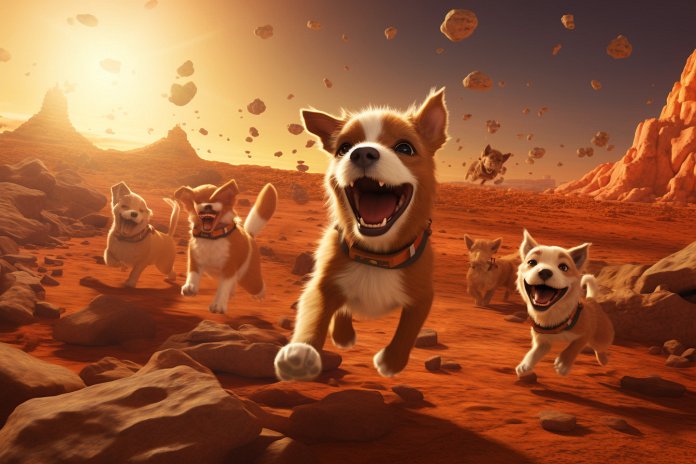
Missions to Mars are exploring the potential for life forms to have once existed on the red planet. In 2013, NASA’s Curiosity rover traveled over the surface of Mars, snapping images that were sent to Earth. An image that was snapped on April 1st by the microscope-like Mars Hand Lens Imager at the end of Curiosity’s robotic arm has created quite a stir! Surprisingly, in the corner of one of the images, there is a formation that appears to be that of a dog with his paw raised, as if to shake. One observer of the image described it by saying, “He looks like a good boy”. There were also images of rock that had the same shape of dog poop. Mr. Carl Fido, a NASA representative has joked that they will take some dog food on their next journey to Mars and plan to start talks with the Humane Society to rescue any strays remaining on Mars. All humor aside, we have a stirring curiosity about the potential for life on Mars and the likelihood of colonization that could potentially include taking your best friend with you.
Signs a Dog Shows When in a New Environment:
If you have a few billion dollars to spare, your move to Mars could happen sooner than later. To take your dog into space or just, perhaps move into a new home, you will still need to think about how your dog will take to the new living arrangement. Moving can be stressful for all parties, so your first concern will be watching for signs of stress with your dog and identifying ways to keep your dog safe and calm during the transitions. Your dog will be coping with the disruptions in the home as you are packing. There may be changes in routine and attention to the dog. The new environment will present your dog with new smells and sounds. This will be a new territory to explore and to establish a sense of security.
When dogs are stressed, they show their discomfort in a number of ways.
A stressed dog may act fearful and will sometimes engage in aggressive behavior as an expression of the dog’s anxiety. Your furry friend has body language as the primary form of communication. If your dog is feeling distressed, you will notice flattened ears, a tucked tail, downcast eyes and a low-bent neck. These are all signs that are telling you your dog is upset. If deeply threatened, you may see your dog cowering, hiding or clinging to you. You may even find your dog hiding.
You are likely to see changes in your dog’s behavior, overall when the animal is under stress. Your dog may act out by soiling in the house, not wanting to go on walks, acting territorial or even hiding. Like humans, you may note changes in eating habits. Your dog may show a decrease or increase in appetite. There may be changes in sleep patterns. Your dog may appear agitated, pacing and unable to settle in. Your dog may become clingy. Fear can bring on fight or flight reactions. The distress may cause a dog to be a fear biter or to be aggressive. It is important to be a good observer of your dog and be watchful of changes in behavior that could indicate your pet is distressed.
Body Language:
Some signs your dog may show if they are stressed during a move include:
– Shaking
– Cowering
– Dropped Ears
– Averting Eyes
– Tail Tucking
Other Signs:
Other signs that your dog is not handling a new environment well are:
– Changes In Eating Patterns
– Diarrhea Or Constipation
– Changes In Activity Level
– Clinging To You For Protection
– Acting Territorial Or Aggressive
History of Dogs in Space:
Dogs were among the first earthlings to be placed in space. In the 1950s and 60s, the Cold War between the Soviet Union and the United States included an arms race for nuclear weapons and a race to space. The Soviets were the first to launch a capsule to orbit the earth. They conducted a series of suborbital flights with 11 dogs before finally launching the Sputnik – 2 with a canine passenger. The scientists needed to determine if a living creature could survive in space. They decided to study the ability of dogs to survive. The scientists chose to use stray dogs for this early testing.
The Science of Taking Dogs to Mars:
Science is searching for an understanding of what is necessary for life on earth and the limits of sustainable life. With over 1700 planets in existence beyond our solar system, scientists question the conditions that would make earthly as well as alien life possible. The four categories necessary for life on earth include energy, carbon, liquid water and miscellaneous factors. Currently, Mars is one of the primary worlds of interest for learning about astrobiology. From studies of Mars, science has enough data regarding the atmosphere, composition, and temperature of the planet to determine that it could be possible to colonize on the planet Mars.
Training Your Dog to Move:
We all know that good dog training is often more about what we train the human to do to be a good owner than what we want the dog to do. Whether you are moving to Mars or to a new block, there are things that you need to do to work with your dog and set up the environment to support your beloved pet to have a smooth adjustment. Before you move, take the time to reinforce obedience commands with your dog. This will help them to be attentive to you. Spray your house with a lasting scent. Before you introduce your dog to the new home, spray that same scent so that the smell is familiar. While you are busy packing, you may need to crate your dog and give your pet needed breaks, play, and exercise.
Safety Tips When Moving Dogs:
– Pay attention to where your dog is when your house is disorganized.
– Do not leave things around that your dog could get into that would be harmful.
– Use a crate to keep your dog secure during moving disruptions and travel.
– Teach others in the new environment how to interact with your dog.
“Moving to a new environment can be stressful for dogs, so it’s important to watch for signs of stress and take steps to keep them safe and calm during the transition.”

Tips & Things to Know
1️⃣ Watch for signs of stress in your dog during a move or transition to a new environment. These signs include shaking, cowering, dropped ears, averted eyes, tail tucking, changes in eating patterns, diarrhea or constipation, changes in activity level, clinging to you for protection, and acting territorial or aggressive.
2️⃣ Understand the history of dogs in space and the science behind potential colonization of Mars. Dogs were among the first animals to be sent into space for testing purposes. With advancements in technology and proper planning, humans may someday be able to live on Mars and potentially bring their dogs with them.
3️⃣ When moving with your dog, take the time to reinforce obedience commands and create a familiar environment. Use a lasting scent in your current home and spray it in the new home to make it familiar to your dog. Crate your dog during packing and introduce them to the new home on a leash. Keep your dog secure during unpacking and maintain their routines to help them adjust to the new environment.
Frequently Asked Questions, Answered ✅
1. What is the potential for life forms to have once existed on Mars?
– Missions to Mars are exploring the potential for life forms to have once existed on the red planet.
2. What was the significance of the image snapped by NASA’s Curiosity rover on April 1st?
– The image captured by the rover showed a formation that appeared to be a dog with its paw raised, creating quite a stir.
3. What are the signs that a dog shows when in a new environment?
– Signs of stress in dogs include flattened ears, a tucked tail, downcast eyes, low-bent neck, hiding, changes in eating habits, changes in sleep patterns, and acting out through aggression or territorial behavior.
4. What is the history of dogs in space?
– Dogs were among the first earthlings to be placed in space during the Cold War between the Soviet Union and the United States. The Soviets conducted suborbital flights with 11 dogs before launching the Sputnik – 2 with a canine passenger named Laika. Unfortunately, Laika died shortly after the launch, but subsequent missions with dogs Belka and Strelka were successful.
5. Is it possible to take dogs to Mars?
– With the construction of properly built enclosures, it may be possible for humans to live on Mars and even take their dogs with them to the new Martian address. Elon Musk is promoting a plan for travel to Mars by 2023.